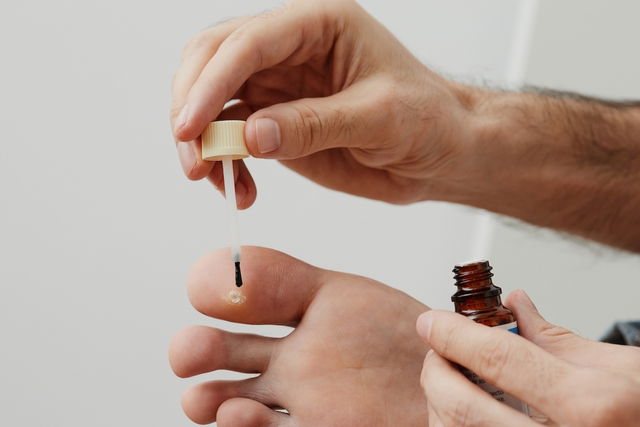Plantar warts are a type of wart that emerge on the bottom of the feet. They are usually a result of HPV (human papilloma virus) infection, and are associated with symptoms like pain and the feeling of lump when stepping on the affected food. Although it is similar to a callus, a plantar wart can spread and grow to other parts of the foot.
It is important to cover the plantar wart and to keep it clean and dry to prevent transmission. Generally, plantar warts resolve on their own within 2 years. When the wart causes symptoms, is large, or spreads and forms other, the doctor may recommend treatment like acidic chemical application or cryotherapy.
If you think you may have a plantar wart, consult your dermatologist for assessment. Once treatment is prescribed, transmission of HPV and new lesions can be prevented.

Main symptoms
The main symptoms of plantar warts are:
- A raised lump or wart on the skin at the bottom of the foot
- Thicker skin in the wart area
- The sensation of a rock or mass under the foot
- Pain when stepping on the affected foot
- Yellow or gray skin over the wart
- Black pinpoint spots in the middle of the wart
- Wart growth or new lesions on the other foot
When symptoms like very intense pain or redness occur, it may be related to cancer, although this is rare. If you suspect a plantar wart, you should consult a dermatologist for evaluation and treatment.
Possible causes
Plantar warts are caused by sub-types of HPV, mainly subtypes 1, 4 and 63. These can invade the skin through microcuts on the feet and stimulate the proliferation of keratinocytes (cells that line the skin). This lead to the appearance of a wart.
In addition, people with immune-related diseases, like HPV or people undergoing chemotherapy, are at higher risk for catching HPV and developing plantar warts.
How it spreads
Plantar warts are transmitted through contact with specific HPV subtypes, which can occur in the following situations:
- Walking barefoot on contaminated surfaces, like around public pools or in public showers
- Using socks or shoes that are used by a person with plantar warts
- Sharing towels with people affected with HPV
- Using contaminated sports or gym equipment
HPV can survive for months on surfaces. However the plantar wart can take time to make its first appearance after entering the skin. This depends on how long the virus takes to stimulate keratinocyte proliferation, which is then released through normal skin peeling.
Plantar warts can appear on other areas of the skin, or they can be transmitted to other people indirectly when it is transferred to a common surface.
Can children get plantar warts?
Plantar warts can occur in anybody, no matter the age. As mentioned, plantar warts are easily transmitted to common surfaces, which become contaminated and can be stepped on by other people.
It is important to keep in mind that although it is the same type of virus, the HPV that causes plantar warts is not the same HPV that causes genital warts. These are sexually transmitted and can increase the risk for colon or uterine cancer.
Treatment options
Treatment for plantar warts is prescribed by a dermatologist and involves the application of salicylic acid or cryotherapy with liquid nitrogen. Although there are other treatments available, like surgical removal or laser therapy, these are less commonly prescribed.
When salicylic acid is prescribed, the doctor may instruct you to apply it every day for several months. Additionally, the doctor may advise you to file the wart down frequently. The acid promotes a mild, chemical exfoliation of the skin, which slowly removed the outermost layer of the skin until the wart is completely removed.
Plantar warts typically take 2 years to disappear on their own without medical intervention, and the doctor may just advise watchful waiting until it resolves. Treatment is only recommended in situations in which the plantar wart causes pain, or if it is very large, if there are many present, or if the patient has an immune-related disease.
How to prevent plantar warts
Plantar warts can be prevented with measures such as:
- Not sharing towels, footwear, socks or personal objects
- Using adequate footwear when showering in public spaces
- Wiping down gym equipment before and after use
- Washing socks frequently
- Treating plantar warts that are present
- Avoiding walking barefoot
- Swapping your socks daily
- Keeping your feet clean and dry
The HPV vaccine is also an important prevention measure against plantar warts.
